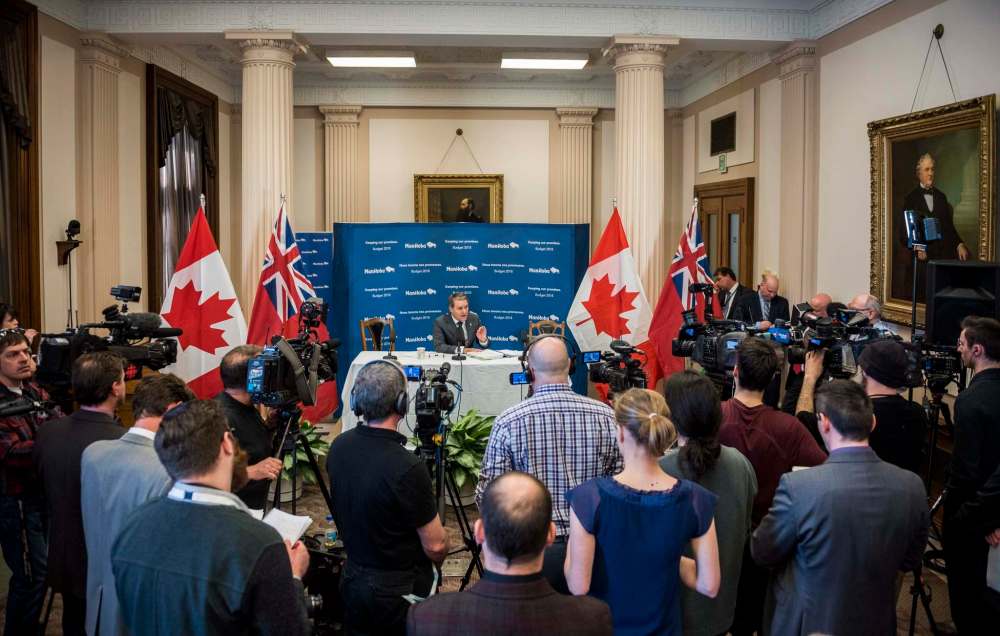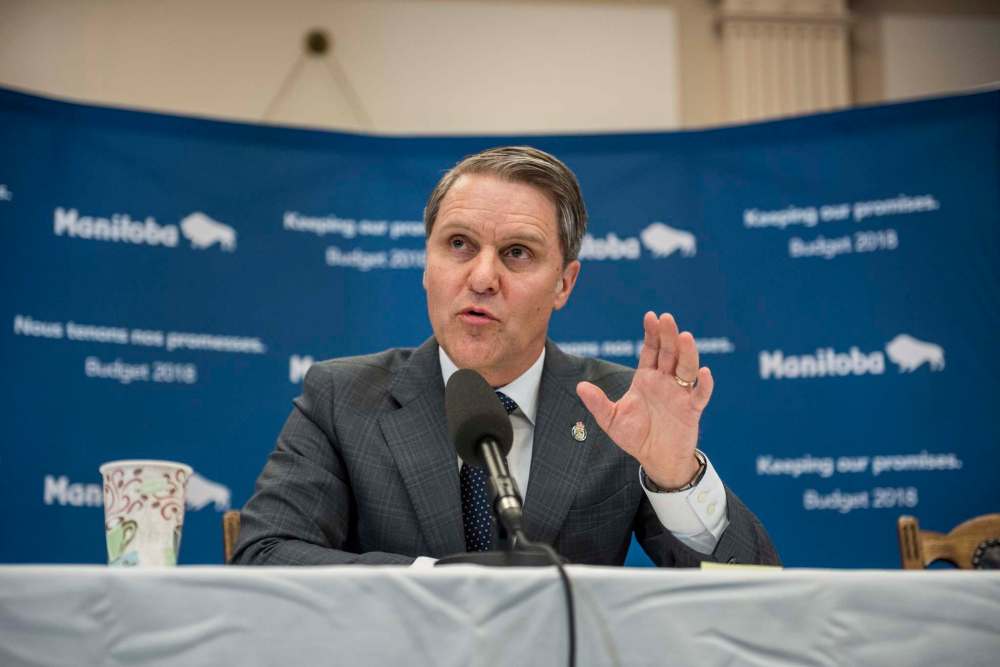Tories continue to chart austere course
Advertisement
Read this article for free:
or
Already have an account? Log in here »
To continue reading, please subscribe:
Monthly Digital Subscription
$1 per week for 24 weeks*
- Enjoy unlimited reading on winnipegfreepress.com
- Read the E-Edition, our digital replica newspaper
- Access News Break, our award-winning app
- Play interactive puzzles
*Billed as $4.00 plus GST every four weeks. After 24 weeks, price increases to the regular rate of $19.00 plus GST every four weeks. Offer available to new and qualified returning subscribers only. Cancel any time.
Monthly Digital Subscription
$4.75/week*
- Enjoy unlimited reading on winnipegfreepress.com
- Read the E-Edition, our digital replica newspaper
- Access News Break, our award-winning app
- Play interactive puzzles
*Billed as $19 plus GST every four weeks. Cancel any time.
To continue reading, please subscribe:
Add Free Press access to your Brandon Sun subscription for only an additional
$1 for the first 4 weeks*
*Your next subscription payment will increase by $1.00 and you will be charged $16.99 plus GST for four weeks. After four weeks, your payment will increase to $23.99 plus GST every four weeks.
Read unlimited articles for free today:
or
Already have an account? Log in here »
Hey there, time traveller!
This article was published 12/03/2018 (2768 days ago), so information in it may no longer be current.
To understand this year’s provincial budget, you need to look at what happened to last year’s provincial budget.
Manitoba Premier Brian Pallister and his Tory government delivered a 2017-18 budget that was chock full of tough love. Spending in core government programs was restrained. There was hardly any new spending, other than a few modest tax cuts.
At that point, hardly anyone would have guessed the real austerity was yet to come.
Over the course of the past year, the government outdid itself in spectacular fashion, generating some profound reductions in spending that likely exceeded even the premier’s wildest dreams.
For example, the 2017-18 budget included meager increases in spending for health care (1.8 per cent) and education (1.1 per cent). These were the smallest year-over-year funding increases in the two core departments in more than 20 years.
Over the course of the year, however, the Tories spent well below those austere budget estimates.
According to updated numbers from the third-quarter fiscal report, core government spending on health care is down $138 million from estimates; education was down about $8 million from estimates.
The government claims it is boosting health-care spending in the upcoming year by 3.2 per cent, and education by less than 1 per cent. However, when you look at the third-quarter report — which contains a more accurate forecast of what the government will actually spend — the real increases are 0.9 per cent for health care and just 0.5 per cent for education.
Critics will point out, with some justification, funding increases that fall below one per cent cannot possibly account for the combined pressures of inflation, demographics and population growth, all of which increase the both the demand for, and costs of, core services.
In defence of the government’s strategy, Finance Minister Cameron Friesen said the reductions in spending represent a new and more disciplined approach to expenditures that largely evaded the former NDP government, and has allowed the government to claim it is spending less but delivering the same level of service.
On the first part of that equation — enhanced fiscal discipline — Friesen is being truthful. The message from the Pallister government has been clear: keep counting pennies until they turn into dollars, and then keep on counting.
This austerity has allowed Manitoba to book a major reduction in the deficit. In last year’s summary budget statement, the government estimated a fiscal year-end deficit of $840 million. In the third-quarter report, it was reduced to $726 million.

In the upcoming 2018-19 fiscal year, the government is forecasting a year-end deficit of $521 million.
Budget over budget, that is a $319-million improvement — one of the largest single-year reductions in deficit since the government started reporting a summary budget statement.
That is a significant accomplishment, one that helps insulate the government against future credit-rating downgrades, while also creating a slim possibility the budget will be balanced in time for Pallister to keep his biggest 2016 election promise: a one-point reduction in the provincial sales tax.
However, those accomplishments will fall on deaf ears unless the Tories can demonstrate they have protected the quality and quantity of core government services.
Have such services suffered over the past two years?
Many members of the public would say yes, and there are stories on the elimination of specific health programs and teacher layoffs that certainly back up the idea the government is providing less to Manitobans and trying to portray it as the same — or more. The Tory government is no doubt aware the erosion of core services is almost never seen by voters as a fair trade for a lower deficit.
Undeterred, Friesen believes as long as voters are patient, they will eventually see the benefit. “We believe that we are making progress in a manner that the majority of Manitobans will find reasonable over time,” he said.
The key words are “over time,” a phrase that is dripping with uncertainty.
Standing in the way of Friesen’s slow-and-steady approach are a number of factors that could radically alter the fiscal trajectory established in the 2018-19 budget unveiled Monday.

Global economic uncertainty, which could trigger hikes interest rates, could knock the Tories off target. So, too, could the hundreds of millions of dollars in back end-loaded tax cuts they have pledged to trigger before they seek re-election in the fall of 2020.
Those cuts include two measures announced in this year’s budget: an increase in the basic personal amount ($1,010 in each of the next two tax years) and a bump to the small-business tax threshold (up by $50,000 to $500,000). Neither will impact government revenue lines until 2020.
Combined with a pledge to cut the PST back to seven per cent — a promise that could cost the province as much as $300 million in revenue — Friesen is facing enormous future tax expenditures that could either sustain or even increase the deficit.
There is every reason to believe Pallister and Friesen have plotted a course to finish the next fiscal year with a smaller deficit than it is forecasting in the budget, largely by under-spending on core services. However, that puts them in a race against time to show this austerity has not ruined the services Manitobans hold most dear.
The smart money says it will be a photo finish.
dan.lett@freepress.mb.ca

Dan Lett is a columnist for the Free Press, providing opinion and commentary on politics in Winnipeg and beyond. Born and raised in Toronto, Dan joined the Free Press in 1986. Read more about Dan.
Dan’s columns are built on facts and reactions, but offer his personal views through arguments and analysis. The Free Press’ editing team reviews Dan’s columns before they are posted online or published in print — part of the our tradition, since 1872, of producing reliable independent journalism. Read more about Free Press’s history and mandate, and learn how our newsroom operates.
Our newsroom depends on a growing audience of readers to power our journalism. If you are not a paid reader, please consider becoming a subscriber.
Our newsroom depends on its audience of readers to power our journalism. Thank you for your support.
History
Updated on Tuesday, March 13, 2018 10:07 AM CDT: Corrects sentence structure.





